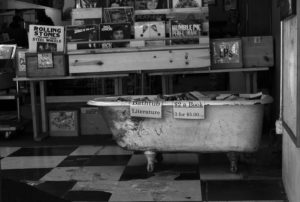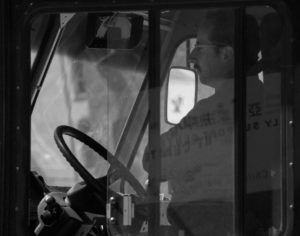Through the Lens: A City’s Last Stand Against the Millennial
A provocatively-dressed hostess waved to a toddler hop-scotching down the street, while simultaneously and without skipping a beat, inviting guests, tourists, and locals alike, to walk into the Garden of Eden gentleman’s club. These gentleman’s clubs which once entertained merchant marines and dock workers line Broadway Street, an area of San Francisco’s North Beach once nicknamed the Barbary Coast.
 At two-thirty in the afternoon, the debauchery that defined the city since its birth in the early 1800s was alive and well, effortlessly finding a tourist or local with a day off from work. On Columbus Street near downtown, bookstores celebrated the beatniks of the 1960s, selling cheap paperback copies of alternative books. A poorly-lit store with old scaffolding advertised “bathtub literature,” and felt right at home in between dirty nightclubs and pizza-by-the-slice shacks. A walk through Chinatown and North Beach reveals two of the city’s oldest and quirkiest neighborhoods, even in the new millennium of technology and skyscrapers.
At two-thirty in the afternoon, the debauchery that defined the city since its birth in the early 1800s was alive and well, effortlessly finding a tourist or local with a day off from work. On Columbus Street near downtown, bookstores celebrated the beatniks of the 1960s, selling cheap paperback copies of alternative books. A poorly-lit store with old scaffolding advertised “bathtub literature,” and felt right at home in between dirty nightclubs and pizza-by-the-slice shacks. A walk through Chinatown and North Beach reveals two of the city’s oldest and quirkiest neighborhoods, even in the new millennium of technology and skyscrapers.
Walking through San Francisco on any given day, one notices new, hip coffee shops filled with laptops popping up in place of old, charming cafes and stores. In North Beach, however, the city’s Italian and naughty cultures continue to thrive, eschewing tech hubs and wifi in favor of cash-only cafes, baristas with distinct Italian accents waiting on customers, and hidden, worn-down saloons promoting cheap liquor and unforgettable stories. In one particular hole in the wall, the owner was such a die-hard fan of the Napoli soccer team that the shop may as well have had a sign saying “Napoli supporters only.” As a customer walked in wearing a jersey for the AC Milan soccer team—a cardinal offense—it was unclear if a brawl would break out or if the owner and customer would bond over their love for all things Italy. Suddenly, an espresso appeared, and order was restored in the name of business.
“Are you a tourist, or a local playing tourist?” Frank asked, turning toward the camera and lens coming his way. Frank, a San Francisco native, refuses to leave his childhood haunts as a way to preserve the memory of the city he once knew – the pre-tech city that prided itself on day-dreaming writers such as Jack Kerouac and Allen Ginsberg, and civil rights activists such as Harvey Milk. “It’s the only place that hasn’t changed too much yet,” he claimed before taking his dog Sherman for a walk through Washington Square Park, a park overlooked by the St. Peter and Paul’s Church, the de-facto cultural center of Italian-Americans in the city since 1884.
Isolation for Preservation
 West of North Beach, colorful paper lanterns weighed down power lines. Looking overhead, clothes hung out of windows, drying the old-fashioned way. A tourist entered a crystal shop to ask a question, only to be turned away with a confused look on his face. Shops and restaurants lined the streets for tourists to wander, but the real Chinatown was hidden in alleyways. Old men played mahjong, women played cards, and printers were hard at work operating massive printing presses on Ross Alley. A man stood, shouting something in Cantonese to one of the workers inside. A distinctly Midwestern family of five stepped towards the open print shop’s door looking for a restroom, and was met with a glare that screamed, “Please don’t enter, we won’t understand each other.” The neighborhood’s hustle and bustle, and the noise in these alleys, pointed to a thriving community that isolated itself from the changes happening in the rest of the city, and in doing so kept the same authenticity from two centuries ago.
West of North Beach, colorful paper lanterns weighed down power lines. Looking overhead, clothes hung out of windows, drying the old-fashioned way. A tourist entered a crystal shop to ask a question, only to be turned away with a confused look on his face. Shops and restaurants lined the streets for tourists to wander, but the real Chinatown was hidden in alleyways. Old men played mahjong, women played cards, and printers were hard at work operating massive printing presses on Ross Alley. A man stood, shouting something in Cantonese to one of the workers inside. A distinctly Midwestern family of five stepped towards the open print shop’s door looking for a restroom, and was met with a glare that screamed, “Please don’t enter, we won’t understand each other.” The neighborhood’s hustle and bustle, and the noise in these alleys, pointed to a thriving community that isolated itself from the changes happening in the rest of the city, and in doing so kept the same authenticity from two centuries ago.
A clearly American postal worker with a bushy moustache and a weary slump in the shoulders indicating a hard day’s work drove by a crowd of Chinese elementary school children. Unlike the older generation, the kids spoke schoolyard English and giggled at the latest trendy toy in their hands: the fidget spinner. After the children left the street and ran into the local community center, the postal worker effortlessly walked down Ross Alley, dropping off packages without saying a word to the residents. Without so much as a hello or goodbye, he walked back towards his truck, and drove off to the sound of horns blaring from angry drivers stuck in San Francisco’s quintessential one-way traffic.
In an age dominated by cutting-edge software applications and developments in technology, these two cultures continue to thrive and fight against their own extinction from a city they helped create. The yearly Chinese New Year Parade and Italian Heritage Parade serve as a reminder that beneath the polished glass high-rises of the city, working-class immigrants maintain their cultural origins and continue to give San Francisco its character. The question, though, is just how long this will last.
Photos by Ilya Faynshteyn
Ilya is not good at standing still. He enjoys long-haul flights to exotic unknowns, getting lost in bustling cities, navigating language barriers, and haggling for unique items.
Ilya is a graduate of the George Washington University in Washington D.C, where he received a master’s degree in Safety & Security studies.
Ilya Faynshteyn





